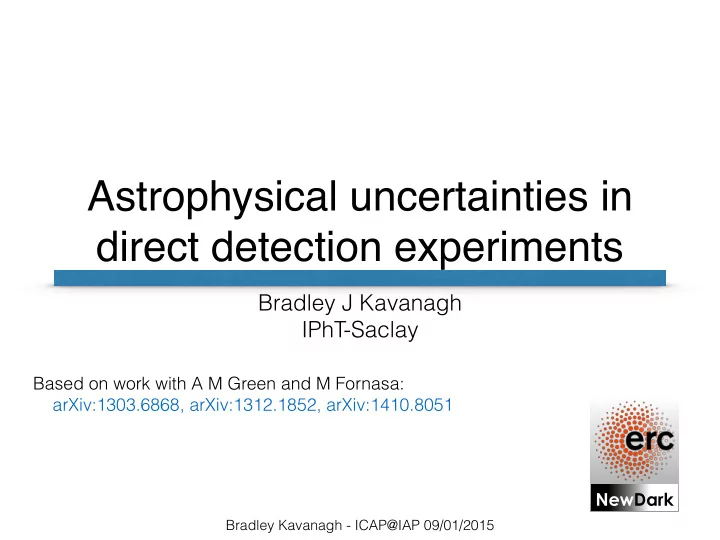

Astrophysical uncertainties in direct detection experiments Bradley J Kavanagh IPhT-Saclay Based on work with A M Green and M Fornasa: arXiv:1303.6868, arXiv:1312.1852, arXiv:1410.8051 NewDark Bradley Kavanagh - ICAP@IAP 09/01/2015
Outline • Direct detection of dark matter • The problem of astrophysical uncertainties • What goes wrong? • A method of controlling astrophysical uncertainties • Combining direct detection and neutrino telescopes Bradley Kavanagh - ICAP@IAP 09/01/2015
Direct detection Aim to measure recoil spectrum as a function of recoil energy, E R Z ∞ d R vf 1 ( v ) d σ ρ 0 = d v d E R d E R m χ m N v min Astrophysics Particle physics s m N E R d σ v min = ∝ 1 /v 2 Typically 2 µ 2 d E R χ N Bradley Kavanagh - ICAP@IAP 09/01/2015
Astrophysical uncertainties Need to know: • DM density, , controls overall normalisation of rate ρ 0 ρ 0 ∼ 0 . 2 − 0 . 6 GeV cm − 3 Read (2014) [arXiv:1404.1938] • Speed distribution, , controls shape of recoil f 1 ( v ) spectrum and is degenerate with DM mass m χ A given nuclear recoil could be caused by a slow-moving, heavy DM particle, or a fast-moving, light particle. Z ∞ f 1 ( v ) d R η ( v min ) = d v ∝ σ η ( v min ) d E R v v min Bradley Kavanagh - ICAP@IAP 09/01/2015
f 1 ( v ) Uncertainties in Typically assume Standard Halo Model (SHM) - a smooth, ρ ( r ) ∝ r − 2 equilibrated halo with . However, there could be a contribution from a dark disk (DD), streams, tidal flows… Bradley Kavanagh - ICAP@IAP 09/01/2015
What could possibly go wrong? Generate mock data for 3 future experiments (Xe, Ge, Ar) assuming a ( m χ , σ SI p ) stream distribution function. Reconstruct assuming: (correct) stream distribution (incorrect) SHM distribution Benchmark Best fit Bradley Kavanagh - ICAP@IAP 09/01/2015
Trying to fix the problem We want to be able to write down a general form for the speed distribution. Try: N − 1 a k v k = a 0 + a 1 v + a 2 v 2 + ... X f 1 ( v ) = k =0 But negative values cannot correspond to physical distribution functions… Many other approaches have also been proposed: Strigari & Trotta, Fox et al., Frandsen et al., Peter, Feldstein & Kahlhoefer… Bradley Kavanagh - ICAP@IAP 09/01/2015
f 1 ( v ) Parametrising We want to be able to write down a general form for the speed distribution which is everywhere positive . N − 1 ! f 1 ( v ) = v 2 exp X a k v k k =0 v 2 Note: factor of comes from volume element of the d 3 v distribution function ( m χ , σ SI p ) Now we can fit not only but also the speed { a k } distribution parameters Bradley Kavanagh - ICAP@IAP 09/01/2015
Result Using parametrisation for f 1 ( v ) Using incorrect f 1 ( v ) assumption about Tested over a range of WIMP masses and distribution functions [arXiv:1312.1852] Bradley Kavanagh - ICAP@IAP 09/01/2015
Cross section degeneracy Z ∞ d R f 1 ( v ) d v ∝ σ d E R v v min This is a problem for any astrophysics-independent method! Bradley Kavanagh - ICAP@IAP 09/01/2015
Including IceCube data IceCube is sensitive to neutrinos from WIMP annihilations in the Sun Solar capture occurs preferentially for low speed WIMPs - they have less energy to begin with Combining IceCube and direct detection mock data should give us complementary information about WIMPs of all speeds Sun is mostly spin-1/2 Hydrogen - so also need to include spin- dependent interactions Bradley Kavanagh - ICAP@IAP 09/01/2015
Complementarity Consider a single benchmark: SI = 10 − 45 cm 2 ; σ p SD = 2 × 10 − 40 cm 2 m χ = 30 GeV; σ p ν µ ¯ annihilation to , SHM+DD distribution ν µ Direct detection only Benchmark Best fit Direct detection + IceCube Bradley Kavanagh - ICAP@IAP 09/01/2015
Conclusions • Poor astrophysical assumptions can lead to biased results for the WIMP mass and cross sections • Demonstrated a general parametrisation which allows us to fit the speed distribution, along with other parameters • Allows an unbiased measurement of the WIMP mass from future direct detection data • Lack of sensitivity to low speed WIMPs means cross section would remain unknown - a problem faced by any method which makes no assumptions • Introducing future IceCube data can break this degeneracy and allows us to pin down the WIMP mass and cross section - and even reconstruct f 1 ( v ) itself! Bradley Kavanagh - ICAP@IAP 09/01/2015
Thank you Questions? NewDark Bradley Kavanagh - ICAP@IAP 09/01/2015
Backup Slides
Mass reconstruction Ideal experiments Realistic experiments Background-free Non-zero backgrounds Perfect energy resolution Finite energy resolution Bradley Kavanagh - ICAP@IAP 09/01/2015
Reconstructing the speed distribution Direct detection only True SHM+DD distribution SHM SHM+DD Best fit Bradley Kavanagh - ICAP@IAP 09/01/2015
Reconstructing the speed distribution Direct detection + IceCube True SHM+DD distribution SHM SHM+DD Best fit Bradley Kavanagh - ICAP@IAP 09/01/2015
How many terms? Bradley Kavanagh - ICAP@IAP 09/01/2015
`Shapes’ of the speed distribution Bradley Kavanagh - ICAP@IAP 09/01/2015
Recommend
More recommend